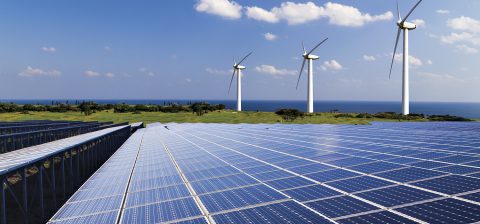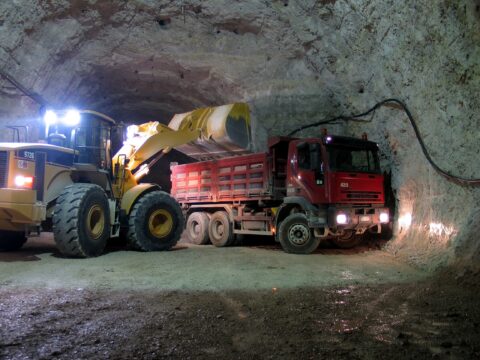SA Mining
On Track
The rise of new industries, such as liquefied natural gas (LNG) and helium, will breathe new life into what is otherwise considered to be a sunset industry, says Renergen CEO Stefano Marani.
JSE-listed Renergen’s subsidiary Tetra4 is busy developing its flagship project, an LNG operation with exceptionally high levels of helium, in Virginia in the Free State. Renergen will become the first company to produce LNG and to sell it locally when it comes into production next year.
According to the local helium pioneer, Renergen has a busy year ahead as it looks to complete project development and deliver phase one production of LNG and helium by 2020.
The company is busy finalising tender bids for its liquefaction equipment – the award of this contract is scheduled for quarter one of 2019, with the gas-gathering system (pipeline to connect the gas wells) scheduled for quarter two and an initial public offering (IPO) on the Australian Stock Exchange (ASX) anticipated later this year.
Two European firms and a Chinese firm are in the running as potential technology partners.
Given that the gas composition of the Virginia project is unique, it requires professionals in the field to tweak the technology in order to deliver the required output.
“There are relatively few technology suppliers in the world with the expertise to engineer technology that can handle the unique gas composition,” he says.
According to Marani, Renergen will align its ASX listing to favourable market conditions.
“The listing is not focused on capital raising; rather, the aim is to give Renergen access to a market that has a deep understanding of the oil and gas industry, and access to a diverse investor base.”
The small-scale LNG project will initially produce an equivalent of 45 000 litres of diesel per day, ramping up to 280 000 litres of diesel equivalent within five years.
“In essence, this means that South Africa will be importing 10 000 gigajoules less per day and this is good news for the country’s balance of payments,” explains Marani.
Fundamentals driving demand for LNG
The LNG market is the fastest-growing energy source – it bridges the gap between fossil fuels and renewable energy. “It is a clean energy source that works to reduce carbon levels,” he notes.
Renergen’s pilot plant in Virginia has, since beginning operation in May 2016, saved the planet almost 2.1 million kilograms of carbon dioxide from entering the atmosphere, and given National Treasury’s call for the implementation of a carbon tax by June, expectations are that industry will have to cough up significantly more for a cleaner future.
According to Marani, the imminent carbon tax is an incentive for diesel-operated vehicle owners to switch to LNG. As a “plug and play” energy source, LNG has been tracking significant demand, especially from the transport sector.
“In fact, 24 million trucks worldwide are already using natural gas, and in China, the number of LNG-fuelled trucks being sold is at a record high. In Europe, LNG-fuelled trucks are on the rise. In South Africa, once Renergen has reached full-scale production of LNG in five years’ time, the company would only supply about 0.7% of the trucking market needs, which leaves much room for other players to participate in this new market,” says Marani.
Helium soars to new heights
While helium is readily available in the universe, economically feasible quantities are rare to find on Earth.
In addition to the range of existing uses of helium, newly emerging technologies are placing further pressure on the commodity, thus widening the demand gap.
Owing to the declining production of helium, the United States, which is one of the largest consumers of helium, has placed it on its list of 35 minerals critical to its economic and national security.
The fact that helium is also placed on a similar list in the European Union is indicative of the importance placed on it as a strategic mineral. Apart from use in party balloons, helium is used widely in coolants (for cooling super-conducting magnets in MRI scanners); in welding; in many chemical processes (like crystal growing); in lasers; and for scientific purposes.
When in production, Renergen will meet 100% of South Africa’s helium needs during phase one of production. South Africa will become the globe’s eighth helium exporter. “Phase two helium production is expected to be significant in global terms, but more work is needed to understand the geology before we build the large-scale helium liquefiers,” says Marani.
As it stands, South Africa imports 300kg of helium per day to meet its needs; however, once in production, the junior miner will initially produce around 350kg of helium per day for both local and international needs, with ramp-up of around 1.5 tonnes within five years.
In 2016, Renergen inked a supply deal with New York-based Linde Global Helium, part of the Linde Group, to commercialise its 187 000-hectare Virginia project for the production. The Linde Group is a supplier of industrial, process and speciality gases.
“We are busy negotiating with several new customers,” Marani tells SA Mining.
The world currently produces some six billion cubic feet of helium per annum. However, owing to increasing uses for helium and declining output, demand is expected to reach seven billion cubic feet per annum by 2020.
Following a recent helium supply shortfall, the price of helium has been robust, with the last public auction by the United States’ Bureau of Land Management achieving a price increase of almost 130% in August 2018 as compared to the previous year’s auction.
Investment intelligence firm Edison Investment Research’s report Helium – Macro View indicates that helium, a scarce resource, is generally found within conventional natural gas reservoirs in small concentrations (<0.5%), making it a valuable by-product.
Renergen’s Virginia project has, however, bucked this trend with its elevated levels of helium concentration of around 3.4%. The most recent drill results from September 2016 indicate increased helium concentrations of up to 11%.
Geographic expansion
Renergen’s production right in Virginia covers 187 000ha and offers an upside to extend exploration over several exploration rights they own too.
According to Marani, there is also potential to expand its footprint in Evander, an area located 120km from Johannesburg, and while the imminent producer is not banking on being in production in the next five to 10 years at the Evander project, exploration wells in the area have shown massive opportunity.





